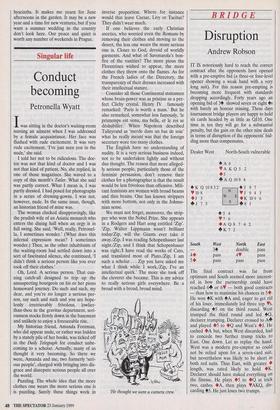BRIDGE
Disruption
Andrew Robson
IT IS notoriously hard to reach the correct contract after the opponents have opened with a pre-emptive bid (a three-or four-level opener showing a weak hand with a very long suit). For this reason pre-empting is becoming more frequent with standards dropping accordingly. Forty years ago an opening bid of 34 showed seven or eight 4s with barely an honour missing. These days tournament bridge players are happy to hold six cards headed by as little as QJ10. One time in ten they will go for a substantial penalty, but the gain on the other nine deals in terms of disruption of the opponents' bid- ding more than compensates.
Dealer West North-South vulnerable 4K Q 10 83 2 V 10 8 ♦ J 3 #1 7 3 4 A 6 VA K Q 5 2 ♦ 5 # A Q 109 4 4J 9 7 VJ 9 4 3 ♦ K 109 6 #8 5
N W E
45 4 V7 6 ♦ A 08 7 4 2 #K 7 2 South West 34 4♦ pass 5♦ pass North East double pass 4,/ pass pass pass The final contract was far from optimum and South seemed more interest- ed in how the partnership could have reached 6+ or 6V — both good contracts — than how to maximise his chances in 5♦. He won 4K with 4A and, eager to get rid of his loser, immediately led three top Vs, discarding 45 on the third round. West trumped the third round and led 4Q, declarer trumping. Declarer crossed to A+ and played ♦5 to 411,Q and West's *J. He cashed ♦A but, when West discarded, had to concede two further trump tricks to East. One down. Let us replay the hand. West was a modern pre-emptor so could not be relied upon for a seven-card suit, but nevertheless was likely to be short in both red suits. Thus East, with greater • length, was rated likely to hold •K. Declarer should have staked everything on the finesse. He plays ♦5 to •Q at trick two, cashes •A, then plays VAKQ, dis- carding 45. He just loses two trumps.


























































 Previous page
Previous page